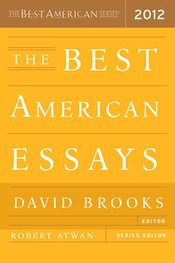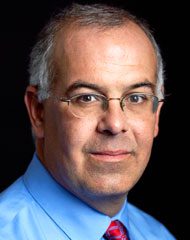
Gore Vidal passed away in July of last year, and Jacques Barzun’s death followed a few months later. If there is a heaven, and if worldviews and cultural paradigms are eternal there, then perhaps those two are again enjoying a wide readership.
In this world, though, nothing lasts—certainly not the consensuses that once allowed for the existence of essayists and public intellectuals in the manner of Vidal and Barzun—and those two writers’ obituaries evoked a past that seems very distant to us now. David Brooks describes that time in his introduction to The Best American Essays 2012, the anthology he edited for Houghton Mifflin’s annual series. It was “the golden age of American nonfiction—the thirty years between 1935 and 1965, when “the mass middlebrow audience still felt it was important to pay attention to what these people said”—meaning essayists and public intellectuals.
Brooks goes on to write, “The essay hit a bad patch for a little while. Yet today I think it’s coming back.” That may be true, but not on the evidence of the collection he has assembled. (The pieces in the book were published in 2011, and readers will recognize some of them, including Jose Antonio Vargas’s blockbuster “Outlaw,” in which he announced that he is an undocumented immigrant.) Although the book contains many very good individual essays, it offers little hope for the essay as a genre. The most interesting pieces apparently draw their energy from a secret anxiety of the authors, who seem to be wondering if maybe it’s time to give up the whole essay-writing racket for good.
The collection’s contributors turn repeatedly to the problem of selfhood, which has been a recurring theme in American essays since Ralph Waldo Emerson’s “Self-Reliance.” In part, “Self-Reliance” is a statement of Emerson’s own aspirations as an essayist. “The highest merit we ascribe to Moses, Plato, and Milton,” writes Emerson, “is that they set at naught books and traditions, and spoke not what men, but what they thought.” His ideal man “would utter opinions on all passing affairs” that “would sink like darts into the ears of men, and put them in fear.” In his introduction to Best American Essays, Brooks writes that Emerson’s “narcissistic self-reliance shtick is demonstrably bad advice and pseudomacho show,” and much of the collection responds to Emerson’s ideas about individuality. The first essay is Benjamin Anastas’s “The Foul Reign of ‘Self-Reliance,’” in which he blames “Emerson’s tacit endorsement of a radically self-centered worldview” for the contemporary conservative movement’s refusal to confront inconvenient facts.

Some of the writers are firmly in Emerson’s camp. In his essay on the value of a college education, Mark Edmundson writes, “From Emerson I learned to trust my own thoughts, to trust them even when every voice seems to be on the other side”—exactly the worldview that Anastas criticizes. When Emerson is not being explicitly discussed, his influence is still apparent, as in Wesley Yang’s response to Amy Chua’s Battle Hymn of the Tiger Mother. Yang describes the difficulty of living according to his own rules, not those of the culture he was born into, which is a major theme in “Self-Reliance.” He is a first-generation Asian American, a writer, and, in contrast to Chua, a committed individualist:
Let me summarize my feelings toward Asian values: Fuck filial piety. Fuck grade grubbing. Fuck Ivy League mania. Fuck deference to authority. Fuck humility and hard work. Fuck harmonious relations. Fuck sacrificing for the future. Fuck earnest, striving, middle-class servility.
Emerson would be pleased.
All the same, the Emersonians in Best American Essays are in the minority. His ideas about selfhood are no longer as convincing as they were during Brooks’s golden age and before. Most of the essays in this book explore the dissolution of the self, a result of sexuality, insanity, senility, or the use and abuse of substances (which are everywhere in this collection—the antidepressant Zyprexa appears in two pieces). Some writers struggle to contain this process of disintegration. Sandra Tsing Loh’s essay on menopause is gregarious and gossipy:
With that, she smeared the tiniest dot of clear estrogen gel on the inside of my wrist, and even though she said it would take a few weeks to take effect, I instantly felt high!
Loh’s writing is funny, smart, and enjoyable, but not much more. Menopause can be a complete replacement of a person’s identity with another, she argues, and the lack of a stable sense of identity is apparent in her frenetic, chatty prose, which is ultimately unsatisfying.
The question of selfhood preoccupies Jonathan Franzen in “Farther Away,” although Daniel Defoe, rather than Emerson, is Franzen’s point of departure. “Robinson Crusoe,” he offers, “was the great early document of radical individualism,” as well as the origin of an essentially narcissistic literary genre (the novel) and the essentially narcissistic culture that form has produced. “Farther Away” is the longest and most ambitious essay in Best American Essays. Set on the Chilean island of Masafuera, in the archipelago that likely inspired the setting of Defoe’s novel, Franzen’s essay is partly an old-fashioned tale of adventure, but combined artfully with literary criticism and with an elegy for his friend David Foster Wallace.
Wallace, Franzen argues, took his own life after suffocating in the selfhood he explored so thoroughly and cultivated so memorably in prose. Decades after the end of Brooks’s golden age, Wallace’s idiosyncratic style gave him the freedom to write monumental essays on grandly intellectual topics: language and democracy in “Tense Present,” what it means to live well in “Consider the Lobster.” Yet Franzen, confronting Wallace’s eventual suicide, concludes that self-reliance is unsustainable, whether in life or in prose. He compares Samuel Richardson’s Pamela favorably to Robinson Crusoe as a model for novelists:
Defoe had staked out the territory of radical individualism, which has remained a fruitful subject for novelists as late as Beckett and Wallace, but it was Richardson who first granted full fictional access to the hearts and minds of individuals whose solitude has been overwhelmed by love for someone else.
Human relationships offer the novelist an escape from solipsism, Franzen concludes. Yet that route is not as readily available in an essay, a form defined by introspection. Brooks also selected David Lawless’s “My Father/My Husband,” a short, beautiful piece narrated in the third person about a man and his wife. She is growing forgetful, and the essay is little more than the repetition of one conversation, with slight variations:
“My husband? You wish! I never married you!”
“Yes you did. We married more than fifty years ago.”
“I never married anyone.”
You learn about this couple’s past together, though the woman remembers very little of it, and about their love for each other, which somehow is still tender and strong. The loss of the sense of self, emphasized by the ambiguous point of view, is as stark in Lawless’s piece as in any other, but his reads more like a short story than an essay. His experiment indicates just how far essays can explore the relationships among the people in them before they begin to turn into something else.
The exhaustive self-examination that characterizes much of Best American Essays often makes for great writing, to be sure, but somehow it doesn’t seem like a mode of composition that will stay interesting forever. What happened to the unselfconscious prose of the essayists of the old school, including H.G. Wells, who could recount sexual escapades that scandalized all of London with the air of a man describing a well-furnished sitting room? Every reader will have his or her own opinion, but it seems unlikely that essays of that kind are coming back, as Brooks believes. They are fading into autobiography and fiction. The last century’s literary conventions have departed like an indignant flock of migratory geese, noisily flapping and pontificating, assuring one another that the winter to come will be long and sunless. The essay has become an awkward, ungainly form that challenges every writer, one that every reader approaches with a degree of skepticism. For now, however, that strangeness is just what gives essays such as the ones in this collection their fascination.




